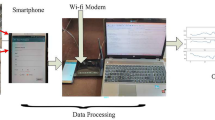Abstract
Sensor-based human activity recognition and health monitoring are attaining great interest in the eye of the researcher as it maintained the privacy of an individual. A model based on the transfer learning for the vertical distribution of cross position sensor data is proposed in this paper. The whole human body participates during an activity like walking, jumping, running, etc. When someone walk, run, jump, upstairs downstairs his hands and lags both act as per the activity. Existing methods of human activity recognition using sensor data learn from one dataset and transfer that learning for another one but in the proposed work combine learning of accelerometer, magnetometer and gyroscope placed at ankle of the body is used as starting point for the lower arm of the body. combination of sensor data from three sensors (accelerometer, gyroscope, magnetometer) obtain better result as compare to an individual and other combinations. Two publically available datasets are used, i.e. mHEALTH and PAMAP2. The proposed model has been compared to the state of art approaches. The experimental results show that the proposed approach performs batter compare to state-of-the-art methods. Model score 98.48 and 98.63 % test accuracy for balanced and unbalanced mHEALTH dataset and achieved 92.00 and 94.19 % test accuracy for balanced and unbalanced PAMAP2 dataset.












Similar content being viewed by others
References
Akbari A, Jafari R (2019) Transferring activity recognition models for new wearable sensors with deep generative domain adaptation. In: Proceedings of the 18th International Conference on Information Processing in Sensor Networks, pp 85–96
Banos O, Garcia R, Holgado-Terriza JA, Damas M, Pomares H, Rojas I, Saez A, Villalonga C (2014) mHealthDroid: a novel framework for agile development of mobile health applications. InInternational workshop on ambient assisted living. Springer, Cham, pp 91–98
Cao L, Wang Y, Zhang B, Jin Q, Vasilakos AV (2018) GCHAR: An efficient Group-based Context—Aware human activity recognition on smartphone. J Parallel Distrib Comput 1:67–80
Chen Y, Xue Y (2015) A deep learning approach to human activity recognition based on single accelerometer. In: 2015 ieee international conference on systems, man, and cybernetics. IEEE, New York, pp 1488–1492
Goodfellow I, Bengio Y, Courville A, Bengio Y (2016) Deep learning. MIT Press, Cambridge
Gu F, Khoshelham K, Valaee S, Shang J, Zhang R (2018) Locomotion activity recognition using stacked denoising autoencoders. IEEE Internet Things J 5(3):2085-93
Guo H, Chen L, Peng L, Chen G (2016) Wearable sensor based multimodal human activity recognition exploiting the diversity of classifier ensemble. In: Proceedings of the 2016 ACM International Joint Conference on Pervasive and Ubiquitous Computing, pp 1112–1123
Hammerla NY, Halloran S, Plötz T (2016) Deep, convolutional, and recurrent models for human activity recognition using wearables. arXiv preprint arXiv:1604.08880
Jalal A, Kim K (2020) Wearable inertial sensors for daily activity analysis based on adam optimization and the maximum entropy Markov model. Entropy 22(5):579
Jiang W, Yin Z (2015) Human activity recognition using wearable sensors by deep convolutional neural networks. In: Proceedings of the 23rd ACM international conference on Multimedia, pp 1307–1310
Kasnesis P, Patrikakis CZ, Venieris IS (2018) PerceptionNet: a deep convolutional neural network for late sensor fusion. In: Proceedings of SAI Intelligent Systems Conference. Springer, Cham, pp 101–119
Khowaja SA, Yahya BN, Lee SL (2017) Hierarchical classification method based on selective learning of slacked hierarchy for activity recognition systems. Expert Syst Appl 88:165 – 77
Lee SM, Yoon SM, Cho H (2017) Human activity recognition from accelerometer data using Convolutional Neural Network. In: 2017 IEEE international conference on big data and smart computing (bigcomp). IEEE, New York, pp 131–134
Ordóñez FJ, Roggen D (2016) Deep convolutional and lstm recurrent neural networks for multimodal wearable activity recognition. Sensors 16(1):115
O’Shea K, Nash R (2015) An introduction to convolutional neural networks. arXiv preprint arXiv:1511.08458
Pan SJ, Yang Q (2009) A survey on transfer learning. IEEE Trans Knowl Data Eng 22(10):1345–59
Pratt LY (1993) Discriminability-based transfer between neural networks 204.
Qian H, Pan SJ, Da B, Miao C (2019) A novel distribution-embedded neural network for sensor-based activity recognition. InIJCAI, pp 5614–5620
Reiss A, Stricker D. Introducing a new benchmarked dataset for activity monitoring. In2012 16th International Symposium on Wearable Computers 2012 Jun 18 (pp. 108–109). IEEE
Singh SP, Lay-Ekuakille A, Gangwar D, Sharma MK, Gupta S (2020) Deep ConvLSTM with self-attention for human activity decoding using wearables. arXiv-2005
Tsiakmaki M, Kostopoulos G, Kotsiantis S, Ragos O (2020) Transfer learning from deep neural networks for predicting student performance. Appl Sci 10(6):2145
Uddin MZ, Hassan MM, Alsanad A, Savaglio C (2020) A body sensor data fusion and deep recurrent neural network-based behavior recognition approach for robust healthcare. Inf Fusion 55:105–15
Wang J, Chen Y, Hu L, Peng X, Philip SY (2018) Stratified transfer learning for cross-domain activity recognition. In: 2018 IEEE International Conference on Pervasive Computing and Communications (PerCom). IEEE, New York, pp 1–10
Xi R, Li M, Hou M, Fu M, Qu H, Liu D, Haruna CR (2018) Deep dilation on multimodality time series for human activity recognition. IEEE Access 6:53381–96
Zebin T, Scully PJ, Ozanyan KB (2016) Human activity recognition with inertial sensors using a deep learning approach. In: 2016 IEEE Sensors. IEEE, New York, pp 1–3
Zhu C, Sheng W (2009) Multi-sensor fusion for human daily activity recognition in robot-assisted living. In: Proceedings of the 4th ACM/IEEE international conference on Human robot interaction, pp 303–304
Du Nguyen H, Tran KP, Zeng X, Koehl L, Tartare G (2020) An improved ensemble machine learning algorithm for wearable sensor data based human activity recognition. In: Reliability and Statistical Computing. Springer, Cham, pp 207–228
Author information
Authors and Affiliations
Corresponding author
Additional information
Publisher’s Note
Springer Nature remains neutral with regard to jurisdictional claims in published maps and institutional affiliations.
Rights and permissions
About this article
Cite this article
Varshney, N., Bakariya, B. & Kushwaha, A.K.S. Human activity recognition using deep transfer learning of cross position sensor based on vertical distribution of data. Multimed Tools Appl 81, 22307–22322 (2022). https://doi.org/10.1007/s11042-021-11131-4
Received:
Revised:
Accepted:
Published:
Issue Date:
DOI: https://doi.org/10.1007/s11042-021-11131-4




